Discover our guide with mouthwatering food writing examples that will make you want to lick the page as you imagine the tantalizing flavors the writers describe.
Have you ever read something and felt you could taste what the writer described? If so, then you’ve read a great example of food writing. This particular writing style covers many specific genres and voices, but at its heart, it’s about making you want to eat and enjoy your food. But what makes a food writer stand out from other types of authors? What makes one restaurant reviewer a better read than another?
Food writing is unlike other types of copywriting, where you can write how you think. There are many popular articles about eating healthy food. Food writing must make the people who read the work desire to eat the food. It has to leave them with mouths watering and stomachs grumbling.
This type of writing is a very creative nonfiction genre, and if you’re ready to dabble in it, one of the best ways to learn what to do is to look at examples of great food writers. This list will showcase some of the best examples of food writing that you can learn about as you work toward becoming a food writer. You might also be interested in our tips for writing about food.
Contents
- 1. The Art of Eating by M.F.K. Fisher
- 2. The Omnivore’s Dilemma by Michael Pollan
- 3. Kitchen Confidential by Anthony Bourdain
- 4. Salt, Fat, Acid, Heat by Samin Nosrat
- 5. Tender at the Bone by Ruth Reichl
- 6. How to Cook a Wolf by M.F.K. Fisher
- 7. Heat by Bill Buford
- 8. Blood, Bones & Butter by Gabrielle Hamilton
- 9. My Life in France by Julia Child
- 10. Feast: Food to Celebrate Life by Nigella Lawson
- Start Reading About Food to Become a Food Writer
1. The Art of Eating by M.F.K. Fisher
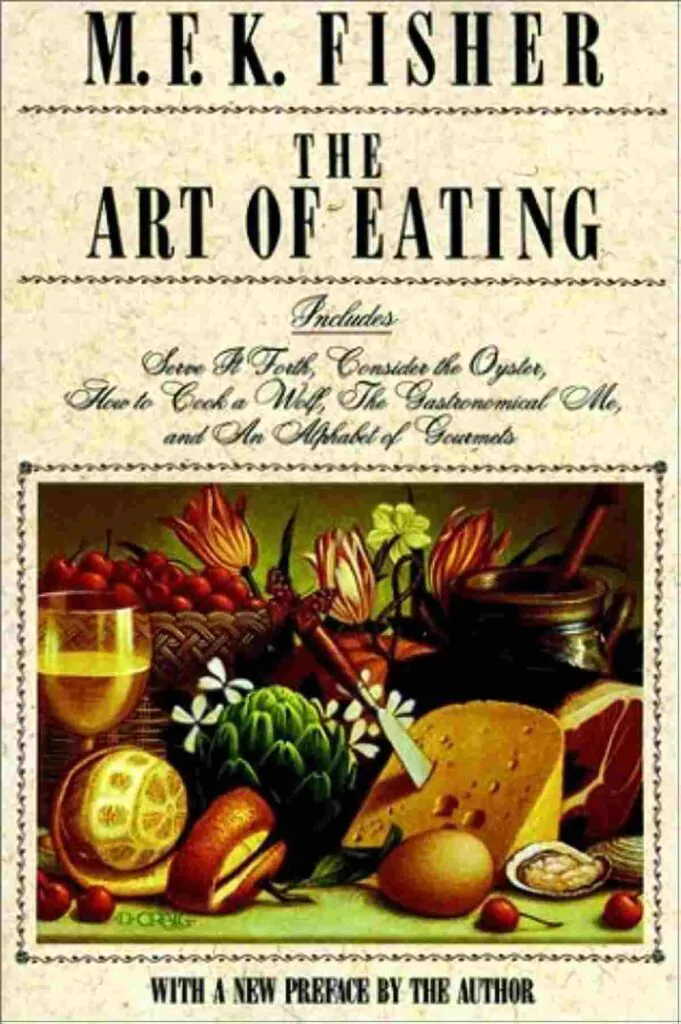
The Art of Eating deserves a top spot on the list because its author, M.F.K. Fisher, was one of the first food writers to be published. This book combines five of her works into one volume: Serve it Forth, Consider the Oyster, How to Cook a Wolf, The Gastronomical Me and An Alphabet of Gourmets. In this book, Fisher uses wit to give her opinion about food, how to best prepare and how to eat it.
Interestingly, even though the book was first published in 1954 and the first work it contains was published in 1937, her descriptive language makes it applicable to modern readers. After all, we all must eat, and Fisher believes we might as well enjoy doing so. Here are some examples of Fisher’s descriptive, witty language as she describes good food.
- Here, she compares the art of breadmaking to a dance and a therapeutic exercise:
- “[Breadmaking is] one of those almost hypnotic businesses, like a dance from some ancient ceremony. It leaves you filled with one of the world’s sweetest smells… there is no chiropractic treatment, no Yoga exercise, no hour of meditation in a music-throbbing chapel that will leave you emptier of bad thoughts than this homely ceremony of making bread.”
- She finds beauty in a mundane task that every baker knows well, making the writing relatable. Using simile in this example, she compares the pastry to feathers, draws in the reader and makes them want to try the dish:
- “You may feel that you have eaten too much…But this pastry is like feathers – it is like snow. It is in fact good for you, a digestive!”
- Here, she explains why writing about food is so important. It’s one of the most basic needs of the human experience, and thus worthy of writing:
- “It seems to me that our three basic needs, for food and security and love, are so mixed and mingled and entwined that we cannot straightly think of one without the others.”
- Used Book in Good Condition
- M.F.K. Fisher (Author)
- English (Publication Language)
- 784 Pages - 02/20/2004 (Publication Date) - Harvest (Publisher)
2. The Omnivore’s Dilemma by Michael Pollan
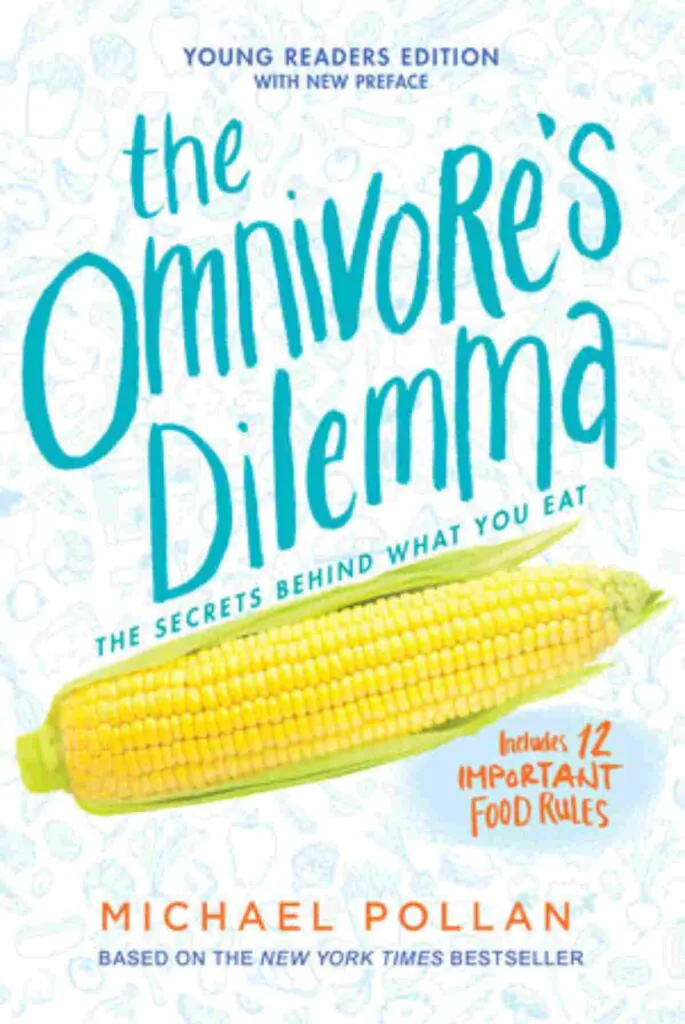
In The Omnivore’s Dilemma, Michael Pollan investigates the environmental effects of the foods humans consume. He delves into the dilemmas created by the food industry. Pollan opens the book by following a calf from birth to slaughter, exploring everything the animal eats and the overall environmental effect of raising it. Next, he takes his investigative journalism to the organic food world, discovering that going “organic” or “free range” may not be as beneficial as the labels make one think.
Finally, he explores sustainable options, such as multi-species farms with practical cycles that support the growth of multiple types of food or the option to revert to hunter-gatherer style eating. The Omnivore’s Dilemma uses investigative journalism to explore the realities of the food industry. Below are some examples of Pollan’s writing:
- Here, Pollan shows the purpose of his book. The author clearly states that he will write about food production, not recipes or home cooking. This statement helps the reader prepare for what is coming:
- “The Omnivore’s Dilemma is about the three principal food chains that sustain us today: the industrial, the organic, and the hunter-gatherer. Different as they are, all three food chains are systems for doing more or less the same thing: linking us, through what we eat, to the fertility of the earth and the energy of the sun.”
- In this excerpt, he shows that he is going to use the book to detail the steps in the food chain until the food gets to the human:
- “Except for the salt and a handful of synthetic food additives, every edible item in the supermarket is a link in a food chain that begins with a particular plant growing in a specific patch of soil (or, more seldom, stretch of sea) somewhere on earth.”
- Finally, he comes to the root of what he sees as the problem and then goes on later in the book to explore how everything comes back to corn.
- “You are what you eat, it’s often said, and if that is true, then what we mostly are is corn – or, more precisely, processed corn.”
- Food
- Pollan, Michael (Author)
- English (Publication Language)
- 450 Pages - 08/28/2007 (Publication Date) - Penguin (Publisher)
3. Kitchen Confidential by Anthony Bourdain
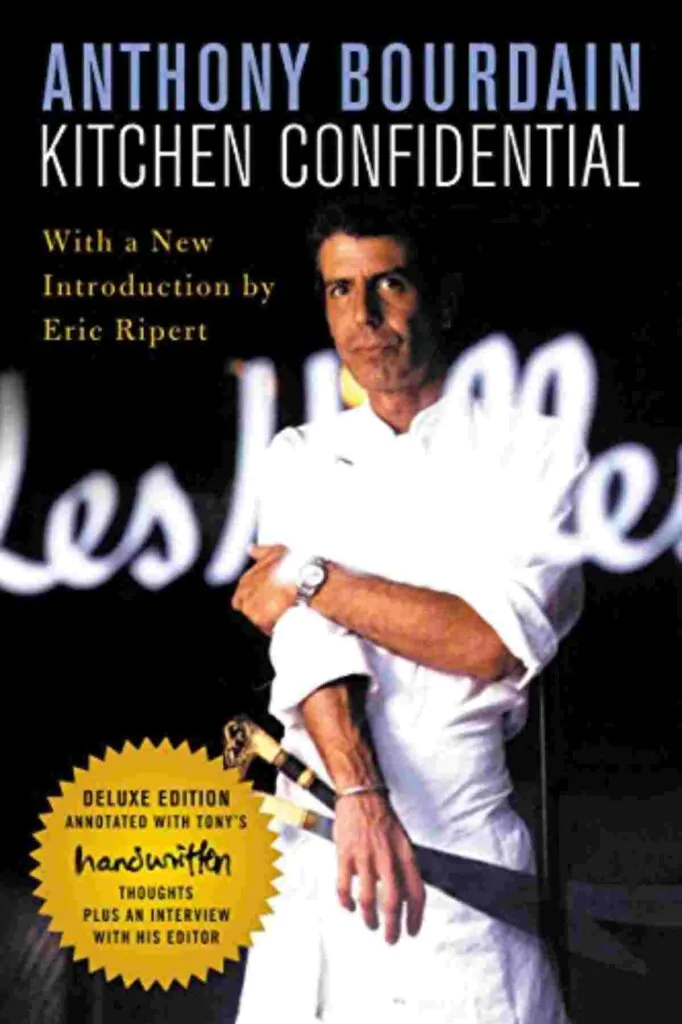
Kitchen Confidential is a food memoir by Chef Anthony Bourdain. In the book, he explores not only his cooking but also his sordid past. The book is filled with humor and explores some of the tricks of the trade of the world’s most elite chefs. This memoir made Anthony Bourdain a well-known name in the food world long before he created his television shows. Below are examples of Bourdain’s writing:
- The author’s not afraid to show some of his strong opinions, as this quote shows:
- “Vegetarians, and their Hezbollah-like splinter faction, the vegans … are the enemy of everything good and decent in the human spirit.”
- In the book, he weaves several cooking tips into his storytelling style. For example:
- “Garlic is divine. Avoid at all costs that vile spew you see rotting in oil in screwtop jars. Too lazy to peel fresh? You don’t deserve to eat garlic.”
- Finally, he gives insight into what life as a chef is really like, as in this quote:
- “At the base of my right forefinger is an inch-and-a-half diagonal callus, yellowish-brown in color, where the heels of all the knives I’ve ever owned have rested, the skin softened by constant immersion in water. It distinguishes me immediately as a cook, as someone who’s been on the job a long time. You can feel it when I shake my hand, just as I feel it on others of my profession. It’s a secret sign, a sort of Masonic handshake without the silliness.”
4. Salt, Fat, Acid, Heat by Samin Nosrat
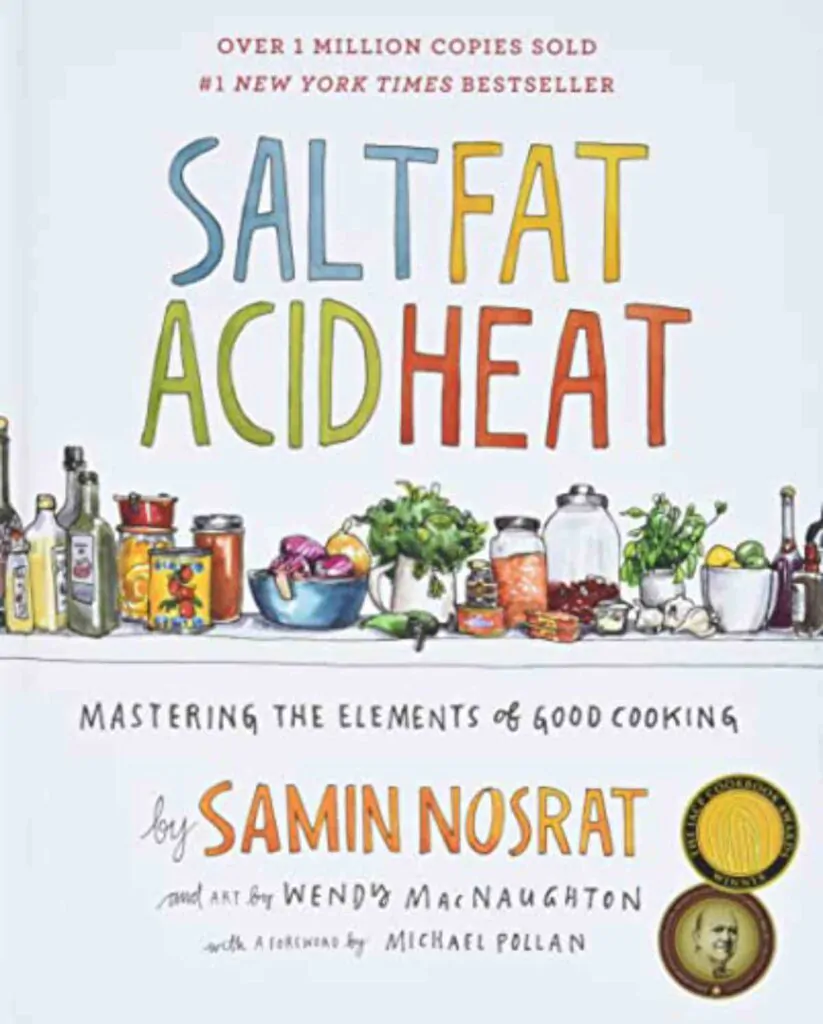
Salt, Fat, Acid, Heat is a New York Times bestselling book by Samin Nosrat. The work shows the author’s approachable writing style as she discusses how to cook with the style of a calm, clear teacher. This writing style is not surprising because Nosrat is a teacher who has educated some of the world’s top chefs.
The book’s writing style is narrative, even though the author’s teaching people how to cook, and it has over 150 illustrations that help people understand how to implement the techniques she shares. It has 100 essential recipes and variations, making it a modern home chef’s go-to cookbook. Below are examples of Samin Nosrat’s writing
- Throughout the book, she leaves tidbits of cooking wisdom.
- “Let all meats—except for the thinnest cuts—come to room temperature before you cook them. The larger the roast, the earlier you can pull it out of the fridge. A rib roast should sit out for several hours, while a chicken needs only a couple,”
- This simple tip can make a world of difference to a cook. The book also gives practical advice for common cooking problems like this:
- “Though we typically turn to sugar to balance out bitter flavors in a sauce or soup, it turns out that salt masks bitterness much more effectively than sugar. See for yourself with a little tonic water, Campari, or grapefruit juice, all of which are both bitter and sweet. Taste a spoonful, then add a pinch of salt and taste again. You’ll be surprised by how much bitterness subsides.”
- Similarly, the book is chock-full of cooking instructions, like this simple phrase:
- “Beef When solid, it’s called suet. Liquid, it’s called tallow.”
- More than 1 million copies sold * New York Times bestseller * Winner of the James Beard Award and multiple IACP Cookbook Awards * Available as a Netflix series *
- Hardcover Book
- Nosrat, Samin (Author)
- English (Publication Language)
- 480 Pages - 04/25/2017 (Publication Date) - Simon and Schuster (Publisher)
5. Tender at the Bone by Ruth Reichl
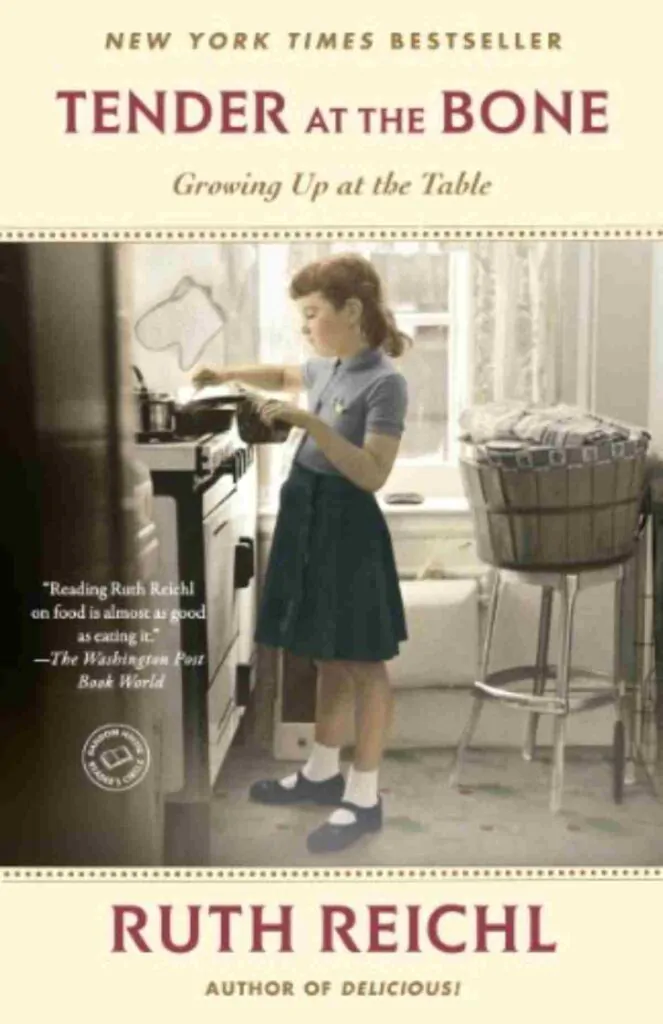
Another food memoir, Tender at the Bone: Growing Up at the Table by Ruth Reichl, recalls what life was like for a culinary legend who grew up in New York City and Connecticut in the 1950s. A master storyteller, Reichl can tell the familiar stories of life as a child and adolescent while tying these tales to the food she was surrounded by at the time. The book takes a linear approach to telling the story of Reichl’s childhood.
In many ways, she found her life defined by food, and through the retelling of the story, she weaves in plenty of humor and some of her favorite food recipes. This book is a New York Times bestseller, and reading it shows clearly why the author is one of the top writers for today’s best food magazines and essay columns. Below are examples of Ruth Reichl’s writing:
- Reichl ties in her love for food with the story of her life.
- “We waited, eating resilient, deeply satisfying bread dipped in spicy oil that tasted exactly like fresh olives. Doug reached out and stroked my knee and I had a sudden conscious thought that I was happy.”
- In this example, she ties the act of eating to the conscious decision to feel happy.
- “I was slowly discovering that if you watched people as they ate, you could find out who they were.”
- In this excerpt, Reichl shows how watching people, specifically when eating, gives a window into who they are. Also, she uses the book to show how food ties people together.
- “It was Mac who first made me think about the way food brought people together — and kept them apart.”
- Reichl, Ruth (Author)
- English (Publication Language)
- 320 Pages - 05/25/2010 (Publication Date) - Random House Trade Paperbacks (Publisher)
6. How to Cook a Wolf by M.F.K. Fisher
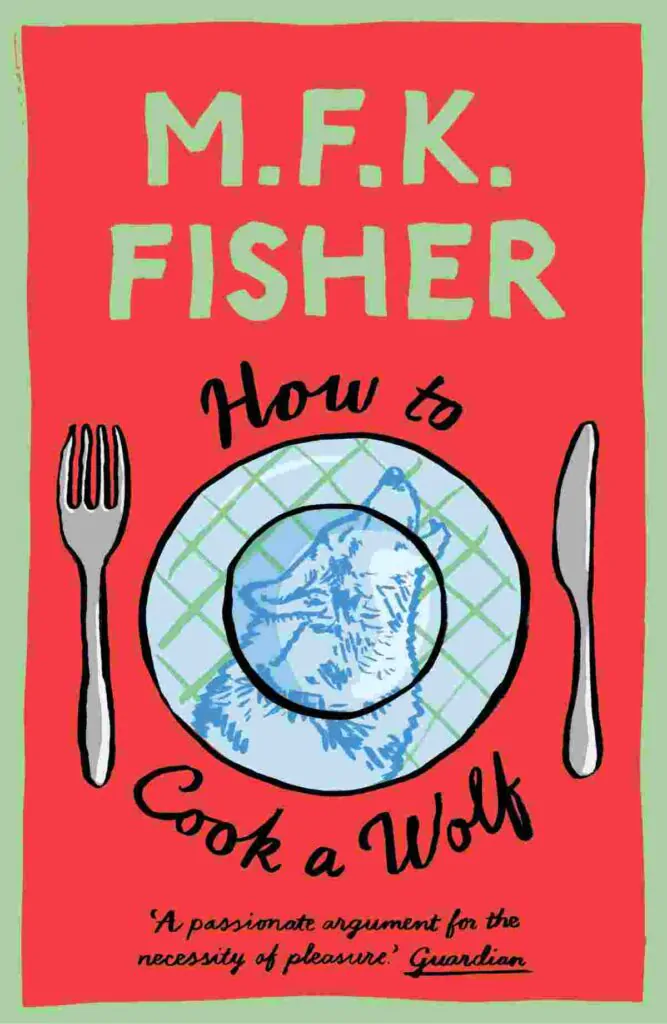
At its surface, How to Cook a Wolf is a cookbook. Yet it’s much more than that when you look a little closer. This book was published during World War II, and its many tips and tricks are about being resourceful and creative in the kitchen when supplies are scarce. In the book, she gives readers a “chin-up” attitude toward shortages, writing about foods that were available rather than ranting about those that weren’t.
The author believes that food, even when sparse, should still taste good and look appealing, and she provides practical tips on how to do this. The “wolf” in the title is the imaginary wolf at the door in times of scarcity, not a real wolf in someone’s kitchen. Here are some examples of M.F.K. Fisher’s writing:
- Throughout the book, readers will find tidbits of wisdom tied to talking about food.
- “All men are hungry. They always have been. They must eat, and when they deny themselves the pleasures of carrying out that need, they are cutting off part of their possible fullness, their natural realization of life, whether they are poor or rich.”
- Throughout the book, you’ll find plenty of wit, such as this quote:
- “And any kitchen idiot would know enough to core the apples.”
- Resourcefulness is commonplace in the book as well, as she explains ways to make more with less, such as keeping a soup pot boiling with leftovers in it:
- “I think soup-pots should be made fresh now and then, like people’s minds at the New Year. They should be emptied and scrubbed and started over again, with clean water, a few peppercorns, whatever little scraps are left from yesterday, and then today’s bones and lettuce leaves and cold toast and such. Set at the back of the stove and left to summer, with an occasional stir from the cook, they can make a fine, clear stock for sauces as well as a heartening broth.”
- M.F.K. Fisher (Author)
- English (Publication Language)
- 224 Pages - 10/01/1988 (Publication Date) - North Point Press (Publisher)
7. Heat by Bill Buford
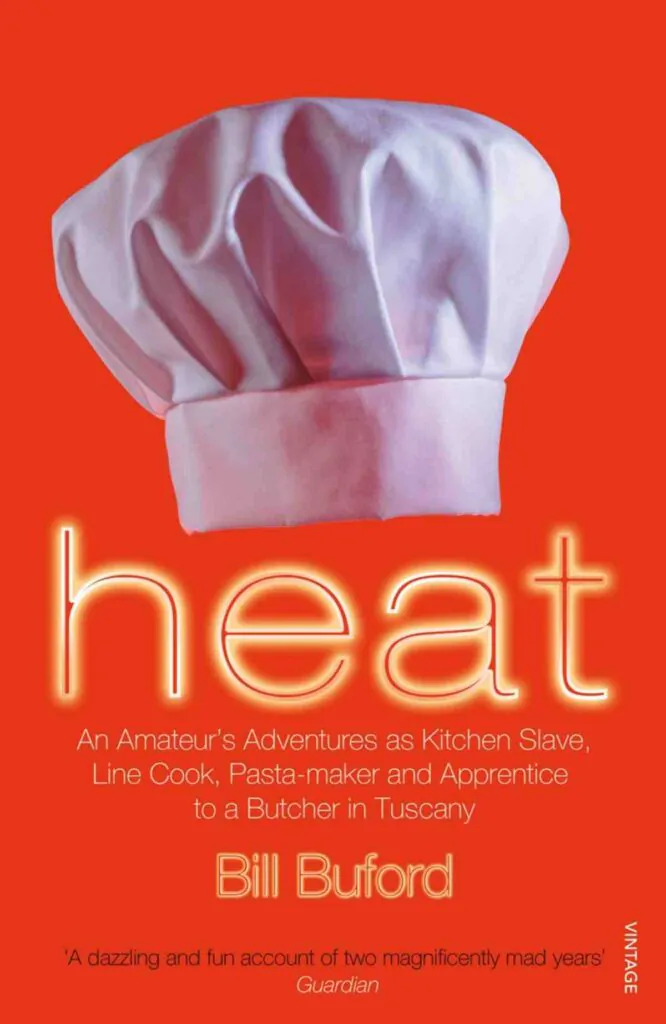
Author Bill Buford thought of himself as a decent cook, yet he always wondered what kind of cook he would be if he were working in a professional kitchen. When Mario Batali’s three-star restaurant in New York, Babbo, offered him training, he took it. Buford quickly found himself under the management of Batali, and it was not long before he ended up in an apprenticeship in Italy with some of the top culinary masters in the world.
Heat follows him on this journey. It serves as a memoir of the time in the kitchen while also chronicling Buford’s rise to fame in the world of food. The book also explores why food and food writing matters. It stands out among food writing because it shares personal experiences and shows behind-the-scenes looks at the world of food, all with plenty of passion woven in. Below are some examples of Buford’s writing style:
- His love for food and vivid description shows in his writing style.
- “A dish was a failure because it hadn’t been cooked with love. A dish was a success because the love was so obvious. If you’re cooking with love, every plate is a unique event—you never allow yourself to forget that a person is waiting to eat it: your food, made with your hands, arranged with your fingers, tasted with your tongue.”
- Heat also has several culinary tidbits woven in, such as:
- “Cooked fat is delicious. Uncooked fat is not. Why do you stuff a goose or duck? Chefs today don’t know because they don’t learn the basics anymore. You stuff the bird so it cooks more slowly. With the empty cavity, you let in the heat, and the bird is cooked inside and out, and the meat is done before your fat is rendered. Stuff your bird with apple and sage, and the fat is rendered first.”
- Finally, his writing explains why he has a passion for cooking:
- “I found, cooking on the line, that I got a quiet buzz every time I made a plate of food that looked exactly and aesthetically correct and then handed it over the pass to Andy. If, on a busy night, I made, say, fifty good-looking plates, I had fifty little buzz moments, and by the end of service I felt pretty good.”
- Buford, Bill (Author)
- English (Publication Language)
- 336 Pages - 06/26/2007 (Publication Date) - Vintage (Publisher)
8. Blood, Bones & Butter by Gabrielle Hamilton
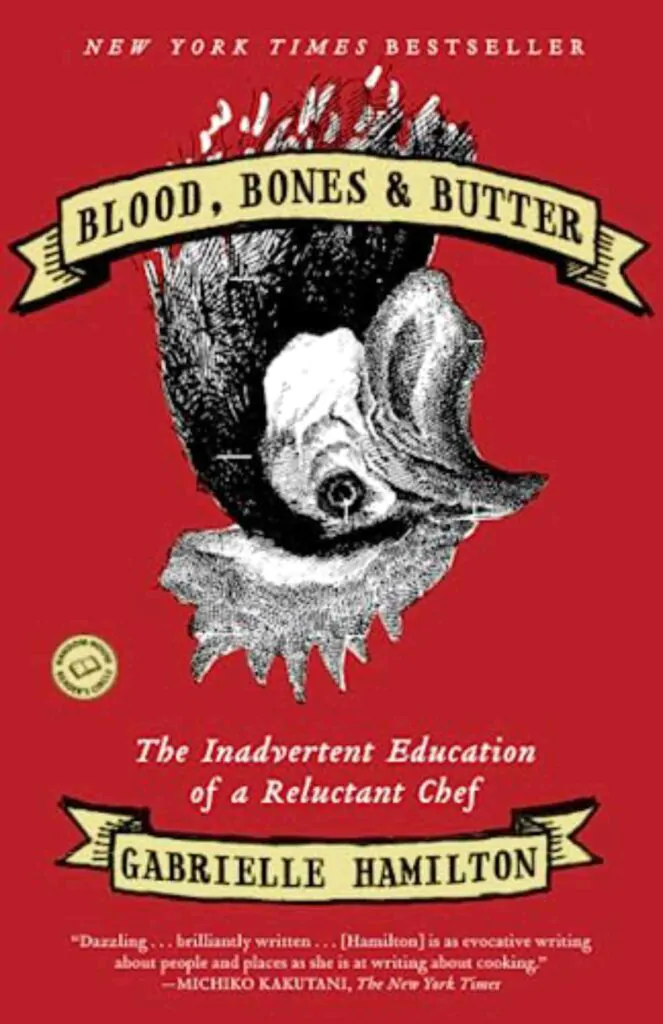
Gabrielle Hamilton owns an acclaimed New York restaurant named Prune, and Blood, Bones & Butter is her memoir of how she journeyed through various kitchens to land her way in the ranks of the world’s top chefs. The book opens in the rural kitchen of her childhood home, then moves to her time exploring Europe, where she dined with strangers. Finally, she lands in Prune, where she faces many challenges in getting the restaurant off the ground. Throughout the book, she is raw and honest in her storytelling and weaves in many food topics. Below are some examples of Hamilton’s writing style:
- The book is open about how people respond to food, as in this example:
- “It’s hard to cook for kids, and when something doesn’t appeal to them, instead of saying a polite no thank you, they instead break into a giant yuk face and shriek “eewww” right in front of you, as if you had no feelings at all.”
- Hamilton gives credit to feeling hungry as a way she grew her passion for cooking, such as:
- “Because so much starving on that trip led to such an enormous amount of time fantasizing about food, each craving became fanatically particular. Hunger was not general, ever, for just something, anything, to eat. My hunger grew so specific I could name every corner and fold of it. Salty, warm, brothy, starchy, fatty, sweet, clean and crunchy, crisp and water, and so on.”
- The book also encourages readers to think about the power of hard work, which is completely necessary to find success as a chef:
- “No future graduate-level feminism seminar would ever come within a mile of the force of that first paycheck. The conviction was instant and forever: If I pay my own way, I go my own way.”
- Great product!
- Hamilton, Gabrielle (Author)
- English (Publication Language)
- 320 Pages - 01/24/2012 (Publication Date) - Random House Trade Paperbacks (Publisher)
9. My Life in France by Julia Child

Chef Julia Child is known for her cookbook Mastering the Art of French Cooking and her television show The French Chef, but her book My Life in France is more of a memoir exploring her time living in France and what it taught her about French cuisine and cooking. This period spent living in France gave her a passion for cooking and teaching about cooking. It explores the spirit Julia had to embrace as she honed her cooking and writing skills to become one of America’s top cooking personalities. Below are some examples of Julia Child’s writing:
- Throughout the book, you’ll find examples of her enthusiasm for both the culture and the food of France, such as:
- “Just speak very loudly and quickly, and state your position with utter conviction, as the French do, and you’ll have a marvelous time!”
- The book also has plenty of self-reflection, which makes it an excellent example of a memoir:
- “Upon reflection, I decided I had three main weaknesses: I was confused (evidenced by a lack of facts, an inability to coordinate my thoughts, and an inability to verbalize my ideas); I had a lack of confidence, which cause me to back down from forcefully stated positions; and I was overly emotional at the expense of careful, ‘scientific’ though. I was thirty-seven years old and still discovering who I was.”
- Child also ties in her love of France with her love of cooking and shows how the two are closely entwined:
- “Good French cooking cannot be produced by a zombie cook.”
- julia child, french school,
- true life story, strong female personality
- inspiration
- Love for life, love for food
- humor, determination, discovery of one's self, true calling
10. Feast: Food to Celebrate Life by Nigella Lawson

A list of the best food writing examples would not be complete without a cookbook making the ranks, and this one is a great choice. Food essay writer Nigella Lawson is known for her columns in well-known print publications, but she also has several bestselling cookbooks to her name, and Feast: Food to Celebrate Life is one of them.
In the book, Lawson pulls together step-by-step recipes and tips to pull off holiday celebratory feasts, but the meals are good enough to use year-round. Unlike many cookbooks, it brings plenty of humor into the recipes, and you can tell they’re written by someone who is a self-proclaimed food critic.
Below are examples of Nigella Lawson’s writing:
- You can see her humor come out in examples like this:
- “In which case, take off the foil, and add the golden paneer cubes, warm them through and revel in the glorious Bollywood brightness of the dish.”
- The book has plenty of step-by-step instructions since it’s at its heart a cookbook:
- “Put the oil into a large skillet–one big enough to take all the ingredients later–and while it’s heating up, cut the paneer into 1/2-inch cubes. Tumble half of them into the hot oil, and fry until they are golden, removing to a double thickness of paper towel.”
- Finally, in the book, she is clear about the importance of food and special occasions:
- “We use food to mark occasions that are important to us in life.”
- Hardcover Book
- Lawson, Nigella (Author)
- English (Publication Language)
- 480 Pages - 10/27/2004 (Publication Date) - Hyperion (Publisher)
Start Reading About Food to Become a Food Writer
Whether you’re considering a freelancing career as a food critic or want to learn more about your favorite foods, the best place to start is with these food writing examples. From cookbooks to memoirs to investigative journalism, these examples show that there are many ways to write about food, and you can use a variety of voices to do so too.
This also means there is room for a new voice in the food writing world. Studying them carefully will show you what it takes to write about food, and they may inspire you to find your own food writer’s voice. If you’re a foodie and a writer, consider transforming that into a lucrative career or side gig as a food writer.
Reading to begin writing? Check out our guide to self-publising on Amazon!